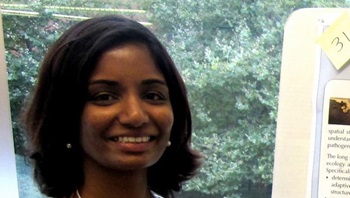Researching Viral Evolution
 Pavitra Roychoudhury came to the University of Idaho from Singapore in mid-winter 2009, greeted by the first snow she'd ever really experienced. She was attracted here by the opportunity to work in the Bioinformatics and Computational Biology program – a great match for her education and work experience in Biomedical Engineering. Here at Idaho she's been researching the evolution of viruses, specifically viruses growing on a surface. Working under the direction of Professor Steve Krone, she employs a combination of mathematical models and lab experiments in her work.
Pavitra Roychoudhury came to the University of Idaho from Singapore in mid-winter 2009, greeted by the first snow she'd ever really experienced. She was attracted here by the opportunity to work in the Bioinformatics and Computational Biology program – a great match for her education and work experience in Biomedical Engineering. Here at Idaho she's been researching the evolution of viruses, specifically viruses growing on a surface. Working under the direction of Professor Steve Krone, she employs a combination of mathematical models and lab experiments in her work.
She's been investigating a puzzle that showed up in lab work: results were indicating that the virus strain was actually evolving to become less infective to its bacterial host, something that seems counterintuitive to the notion of evolution moving towards increasing fitness for survival. But Pavitra found that the mathematical models she built predicted an “optimal infectiveness” for the virus that varies with the density of the hosts on the surface. She explains the phenomenon using an analogy from optimal foraging theory. “When a bee or a humming bird goes from flower to flower to find food, is it better for it to choose the first flower it encounters or to fly to find one a little further away? It depends on how many flowers are available and on the number of other foragers competing for the same flowers. If the field is sparsely populated with flowers, it might be best for the birds to pick the first flower encountered rather than spending energy to fly to flowers that are far away despite the risk of losing out to competitors. On the other hand, in a dense field where there is plenty for everyone, it might be better to explore rather than pick the nearest flower, since the cost of exploration is lower and there is less competition for resources.” In the same way, the virus finds its ideal level of infectiveness depending on how many hosts are available, and that can sometimes mean evolving to decrease that level.






